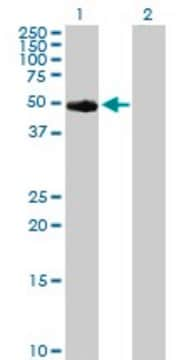MABC592
Anti-TRP1/TYRP1 Antibody, clone TA99, Azide Free
clone TA99, 1 mg/mL, from mouse
Synonym(s):
5,6-dihydroxyindole-2-carboxylic acid oxidase, DHICA oxidase, Catalase B, Glycoprotein 75, Melanoma antigen gp75, Tyrosinase-related protein 1, TRP, TRP-1, TRP1
About This Item
Recommended Products
biological source
mouse
Quality Level
antibody form
purified immunoglobulin
antibody product type
primary antibodies
clone
TA99, monoclonal
species reactivity
human, mouse
concentration
1 mg/mL
technique(s)
blocking: suitable (interfering antibodies)
flow cytometry: suitable
immunohistochemistry: suitable
immunoprecipitation (IP): suitable
western blot: suitable
isotype
IgG2aκ
NCBI accession no.
UniProt accession no.
shipped in
wet ice
target post-translational modification
unmodified
Gene Information
human ... TYRP1(7306)
Related Categories
General description
Immunogen
Application
Blocking of Interferring Antibodies Analysis: A representative lot from an independent laboratory suppressed the growth of subcutaneous B16 tumors (Patel, D., et al. (2008). Anticancer Res. 28(5A):2679-2686.).
Activity Assay Analysis: A representative lot from an independent laboratory improves anti-tumor efficacy by augmenting systemic CD8+T cell responses to tumor cells (Saenger, Y. M., et al. (2008). Cancer Res. 68(23):9884-9891.).
Immunoprecipiptation Analysis: A representative lot from an independent laboratory immunoprecipiated TRP1/TYRP1 from B16 cell lysate (Srinivasan, R., et al. (2002). Cancer Immun. 19(2):8.).
Apoptosis & Cancer
Apoptosis - Additional
Quality
Western Blotting Analysis: 1 µg/mL of this antibody detected TRP1/TYRP1 in 10 µg of mouse skin tissue lysate.
Target description
Physical form
Storage and Stability
Handling Recommendations: Upon receipt and prior to removing the cap, centrifuge the vial and gently mix the solution. Aliquot into microcentrifuge tubes and store at -20°C. Avoid repeated freeze/thaw cycles, which may damage IgG and affect product performance.
Disclaimer
Not finding the right product?
Try our Product Selector Tool.
Storage Class Code
12 - Non Combustible Liquids
WGK
WGK 2
Flash Point(F)
Not applicable
Flash Point(C)
Not applicable
Certificates of Analysis (COA)
Search for Certificates of Analysis (COA) by entering the products Lot/Batch Number. Lot and Batch Numbers can be found on a product’s label following the words ‘Lot’ or ‘Batch’.
Already Own This Product?
Find documentation for the products that you have recently purchased in the Document Library.
Our team of scientists has experience in all areas of research including Life Science, Material Science, Chemical Synthesis, Chromatography, Analytical and many others.
Contact Technical Service








